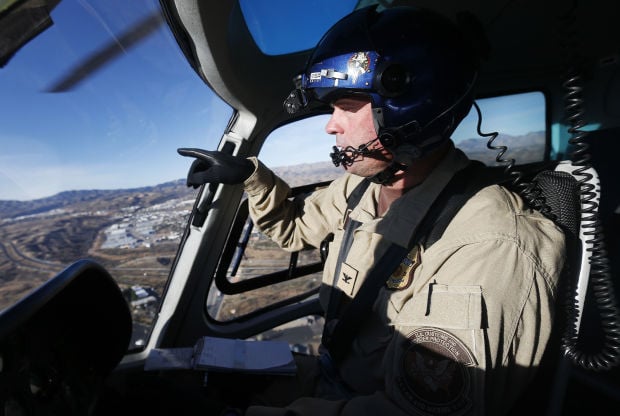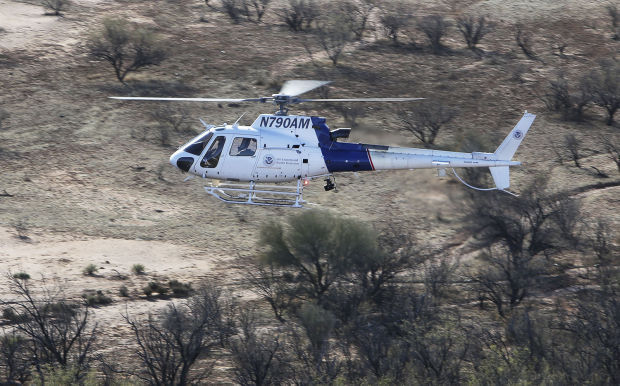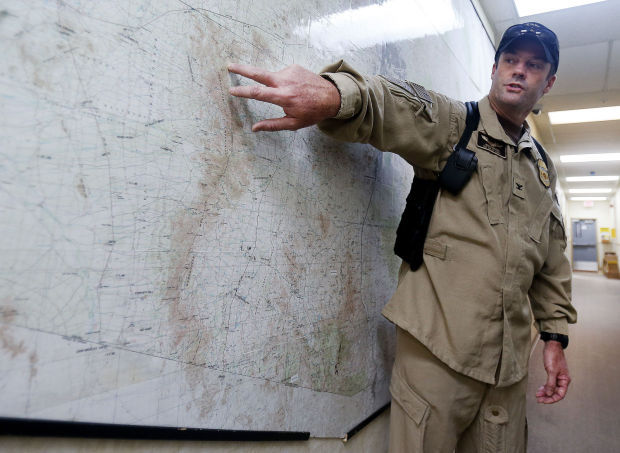Agents in the Office of Air and Marine often work in the shadow of their colleagues in the green or blue uniforms — but the lesser-known branch of Customs and Border Protection is the largest air and maritime law-enforcement organization in the world.
Their Black Hawks and Astars will by flying above Glendale today during the Super Bowl, making sure airspace restrictions are being respected and ready to respond if needed.
Aircraft and marine vessels have been part of border enforcement for decades. But it wasn’t until 2006 that CBP consolidated all assets to create the Office of Air and Marine. Today, it has more than 1,200 agents, 268 aircraft, and 293 patrol and interdiction vessels. It operates on an annual budget of roughly $700 million.
Office of Air and Marine agents work with a range of agencies to do tasks that include providing security during a State of the Union address or the Super Bowl, to humanitarian support after natural disasters, such as the earthquake in Haiti. They also work in foreign countries to prevent drugs from reaching the United States.
In Southern Arizona, one of their primary partners is the Border Patrol.
While the office is an investigative agency, here its agents help the Border Patrol track groups from the air, transport agents to the top of hills to arrest cartel scouts and, lately, a lot of their focus is using their Black Hawks for searches and rescues.
As enforcement in urban areas has increased, smugglers started to take groups into increasingly rugged terrain. Many of the rescues are now concentrated on the Tohono O’odham Nation west of Tucson, said Jessie Scruggs, supervisor in the Tucson branch. Last fiscal year, the Tucson Sector of the Border Patrol recorded 459 rescues.
UNFORGIVING TERRAIN
Agents such as Scruggs, who has patrolled the southern border from the air for 13 years, know about trends and traffic as much as the Border Patrol agents on the ground.
On a recent Astar helicopter ride, Scruggs, a former military pilot, pointed to some hills by the Asarco mine on the way to Nogales. About seven years ago, he said, those hills were littered with backpacks and other trash left behind by the migrants heading north. Now, the hills look empty.
Farther down, Scruggs pointed to trails still visible by the Ruby Road area in Nogales.
“Ruby still gets quite a bit of traffic, both people and dope,” he said as the white AS350 continued its flight over deep canyons and rolling hills exposing the vastness and unforgiving terrain of the Southern Arizona desert.
The air coordinator transmitted through the radio that Border Patrol agents were tracking a group of four or five crossers. Later, another call had two more walking on the side of a road.
Groups are now much smaller, Scruggs said. Traffic has slowed down, he said, partly due to the economy and partly due to enforcement.
But things weren’t always like that.
At the peak of traffic, agents apprehended groups of 100 people just about daily. The air agents were like firefighters, Scruggs said, responding only when a call came in.
Now, border crossers are harder to find because they travel in such small groups, but it takes the same resources.
As the helicopter flew by Baboquivari Peak, a more than 7,000-foot granite monolith about 60 miles west of Tucson and the Tohono O’odham’s most sacred site, Scruggs spotted a solar panel he hadn’t seen two days prior.
That spot probably was used by scouts, he said, whom the cartels pay to help them move their loads and groups of people without being caught.
PROVIDING AIR SUPPORT
As a supervisor, Scruggs tries to get out into the field once a week and to have patrols in the air for up to 4½ hours at a time.
It serves two purposes, he said: It’s a deterrent and it allows air agents to respond more quickly.
In the Tucson branch, the Office of Air and Marine has 24 aircraft and three drones.
When Scruggs started, there were only two Astars, or AS350, helicopters, he said; now there are 13.
The agents also have a handful of Black Hawks, although only two or three normally operate at a given time while the rest are down for maintenance.
When agents go out in the field, one of the first things they ask for is air support, said John Lawson, a Border Patrol agent and CBP spokesman.
Agents on the ground can only see what’s right in front of them, Lawson said, but the helicopter can spot if smugglers are hiding in a wash, if they are carrying weapons or backpacks, how many there are and how far ahead they are from the agents.
The aircraft are also equipped with day and night cameras that Lawson said are extremely handy.
While the Border Patrol has surveillance towers and trucks mounted with cameras, he said, they still have limitations that are overcome by the aircraft.
“It all works together,” Lawson said. “If we don’t need a helicopter and have a tower, we will take advantage of that.”
The agents used a common military term — force multiplier — to describe how it all works together.
PERFORMANCE MEASURES
In the past, the Office of Air and Marine has struggled to meet the flight hours it was funded for and to meet its goal of support requests fulfilled.
The Government Accountability Office recommended in a 2012 report that the office take additional steps to make sure the mix of resources it had was good for the demand and that they were sent to where they were needed the most.
Earlier this year, the Office of Inspector General was critical of the unmanned aerial system, or drone, program, saying that after eight years and hundreds of millions of dollars, CBP had yet to prove its value.
It said the office still didn’t have a reliable method of measuring its performance and that its impact stemming illegal immigration has been minimal — drone surveillance was credited with assisting in less than 2 percent of CBP’s apprehensions of illegal border crossers.
Flight time also fell far short of the office’s goal of 16 hours per day, 365 days per year, the report found. The drones, which were often grounded by weather, were airborne for only 22 percent of those goal hours.
In the Tucson branch, the three drones together flew an average of six hours a day last fiscal year, totaling 2,227 hours.
But officials with the Office of Air and Marine insisted the drones were efficient and disputed some of the findings.
The purpose of the drones is not to apprehend but to detect, said Gerald Burgess, a spokesman for the Tucson branch.
The program is not very old and is still evolving. But most people would agree, he said, that on some level it’s beneficial.
The office measures its success based on the pounds of narcotics it helps seize or the number of people it helps arrest, as well as by the feedback of partnering agencies such as the Border Patrol, Burgess said.
Officials are always reassessing their priorities based on the needs, especially when it comes to saving a life — whether that be of an agent or an undocumented crosser, he said.
“We exist to serve the public as needed.”






